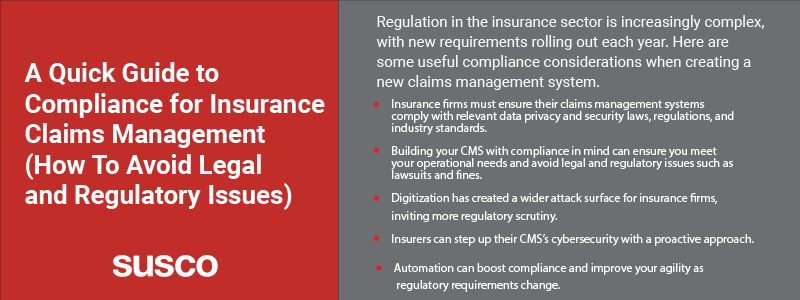Regulation in the insurance sector is increasingly complex, with new requirements rolling out each year. Here are some useful compliance considerations when creating a new claims management system.

Insurers are now operating in an increasingly complex environment, requiring them to innovate, increase commitments, cope with new risks, and maintain higher standards. Customer protection, data privacy, and security continue to trigger regulatory scrutiny and shape new challenges.
As an industry leader, you may be already considering how to navigate this new landscape when building a claims management system for insurance – and it’s a daunting task.
The good news is that you’re on the right path.
Understanding these key compliance considerations can help you build a claims management system that meets your operational needs and helps you avoid legal and regulatory issues in the future.
Data privacy and security compliance
The rapid growth of digitization has meant insurance firms now handle increasingly large volumes of ultra-sensitive customer data. This makes them highly attractive targets for bad actors.
While the threat of data breaches is nothing new, the stakes have risen significantly in the wake of three regulations:
- The California Consumer Privacy Act (CCPA)
- The General Data Protection Regulation (GDPR)
- The NAIC Insurance Data Security Model Law
Regulators are probing how insurance firms store and protect data with unprecedented rigor by pushing for more robust testing, heightened controls, and faster and more detailed disclosures – and there are ramifications for the entire insurance industry.
In this context, insurers must consider how they can design and implement robust privacy and security plans to minimize their attack surface, increase resilience to threats, and protect customer data.
While there is no hard and fast rule about the best way to safeguard critical infrastructure online, using the National Institute of Standards and Technology (NIST) Cyber Framework as a reference when building a new claims management system for insurance can significantly boost its security and help you stay one step ahead of threat actors.
Here are some useful considerations for improving data privacy and your system’s overall cyber resilience:
1. Early detection
There’s nothing worse than learning of an attack after the damage is already done. Luckily, a proactive cybersecurity approach can help you avoid this situation. Integrating auditing and early detection capabilities with your claims management system for insurance can help you identify attacks as they occur. Similarly, privileged access management tools can help you control and monitor customer data access, notifying you whenever there’s abnormal employee activity or credential abuse.
Prioritizing these considerations will enable you to take immediate corrective actions and neutralize threats before any severe damage to your company.
2. Defense capabilities
How will your system cope when it becomes a target? Assessing the CMS’s defensive capabilities can help you identify and fix errors that may leave it vulnerable to internal and external cyberattacks. This means conducting a regular code review, penetration and scenario-based testing, and all other vulnerability assessments – either in-house or through a trusted and experienced cybersecurity team.
3. Cybersecurity awareness among employees
While building a robust claims management system for insurance with all the essential security features is crucial, your system’s security is only as strong as its weakest link: the internal end users. Training your employees on cybersecurity best practices such as using strong passwords, turning on two-factor authentication, and identifying cyberattack attempts – such as social engineering and phishing – can further improve your detection and prevention capabilities.
4. Disaster recovery plan
No insurance firm hopes to be the victim of a data breach, but it sometimes happens. It’s essential to think about your cyberattack response plan when creating a new CMS. The recovery plan should address issues such as data backup, downtime minimization, and alternative communication methods to protect client information and business continuity in the face of unforeseen events.
Additionally, all stakeholders should know their role during a data breach, who to report to, and within what time frame.
Regulatory compliance
When building a claims management system for insurance, it’s also essential to consider how to streamline claims management while keeping up with the ever-changing regulatory requirements – and there’s no better way than through automation. Here are a few things to keep in mind:
- End-to-end decision automation can give you the advantage of modeling, automating, governing, and managing complex compliance scenarios.
- A unified approach that combines business expertise, compliance intelligence, and agility as regulatory requirements change.
- Using ML and AI technology for early risk detection can boost regulatory compliance and reduce the overall potential of fraud, for example.
- These technologies can streamline your auditing and records keeping process, providing more accurate data and helping you integrate it into production systems and workflows in real time – or to intervene when necessary.
Remember, you have a responsibility to comply with relevant laws, regulations, and industry standards. It’s also in your best interest to secure all customer data with a robust data and security policy enforced by all stakeholders – not just behind a firewall.
Compliance for insurance claims management with Susco
Maintaining day-to-day operations while keeping up with consumer expectations, changing regulatory standards, and emerging technologies already requires substantial time, effort, and expertise. And, compliance for insurance claims management will only get more complex.
Susco can help you create a modern, resilient claims management system for insurance that offers more effective compliance risk management. That way, you’ll be ready for whatever the future holds. With combined decades of experience in Microsoft Stack programming in the insurance industry, our experts understand how to build custom solutions to enhance insurance policy workflows and regulatory compliance.
Don’t get stuck building your claims management system for insurance. Reach out today for expert help.